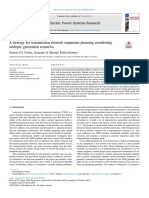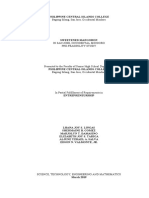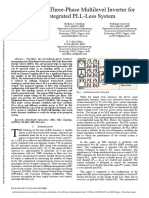0 ratings0% found this document useful (0 votes)
117 viewsElectronic Paper
Electronic Paper
Uploaded by
Meenu NagpalThe document summarizes electronic paper, its development, technologies used, advantages, and disadvantages. Some key points:
- Electronic paper uses microcapsules or beads embedded in plastic that form images when electricity is passed through. It can hold images without power like regular paper.
- It was first developed in the 1970s and major developments occurred in the 1990s with new technologies like E Ink.
- Technologies used include electrophoretic displays, electrowetting, and electrofluidic displays which manipulate particles or fluids with electric fields to create images.
- Advantages are low power use, flexibility, and ease of reading like paper. Manufacturing is also simpler than LCDs.
-
Copyright:
© All Rights Reserved
Available Formats
Download as DOC, PDF, TXT or read online from Scribd
Electronic Paper
Electronic Paper
Uploaded by
Meenu Nagpal0 ratings0% found this document useful (0 votes)
117 views6 pagesThe document summarizes electronic paper, its development, technologies used, advantages, and disadvantages. Some key points:
- Electronic paper uses microcapsules or beads embedded in plastic that form images when electricity is passed through. It can hold images without power like regular paper.
- It was first developed in the 1970s and major developments occurred in the 1990s with new technologies like E Ink.
- Technologies used include electrophoretic displays, electrowetting, and electrofluidic displays which manipulate particles or fluids with electric fields to create images.
- Advantages are low power use, flexibility, and ease of reading like paper. Manufacturing is also simpler than LCDs.
-
Original Title
272901351-Electronic-Paper
Copyright
© © All Rights Reserved
Available Formats
DOC, PDF, TXT or read online from Scribd
Share this document
Did you find this document useful?
Is this content inappropriate?
The document summarizes electronic paper, its development, technologies used, advantages, and disadvantages. Some key points:
- Electronic paper uses microcapsules or beads embedded in plastic that form images when electricity is passed through. It can hold images without power like regular paper.
- It was first developed in the 1970s and major developments occurred in the 1990s with new technologies like E Ink.
- Technologies used include electrophoretic displays, electrowetting, and electrofluidic displays which manipulate particles or fluids with electric fields to create images.
- Advantages are low power use, flexibility, and ease of reading like paper. Manufacturing is also simpler than LCDs.
-
Copyright:
© All Rights Reserved
Available Formats
Download as DOC, PDF, TXT or read online from Scribd
Download as doc, pdf, or txt
0 ratings0% found this document useful (0 votes)
117 views6 pagesElectronic Paper
Electronic Paper
Uploaded by
Meenu NagpalThe document summarizes electronic paper, its development, technologies used, advantages, and disadvantages. Some key points:
- Electronic paper uses microcapsules or beads embedded in plastic that form images when electricity is passed through. It can hold images without power like regular paper.
- It was first developed in the 1970s and major developments occurred in the 1990s with new technologies like E Ink.
- Technologies used include electrophoretic displays, electrowetting, and electrofluidic displays which manipulate particles or fluids with electric fields to create images.
- Advantages are low power use, flexibility, and ease of reading like paper. Manufacturing is also simpler than LCDs.
-
Copyright:
© All Rights Reserved
Available Formats
Download as DOC, PDF, TXT or read online from Scribd
Download as doc, pdf, or txt
You are on page 1of 6
Term Paper Review
ECE 202
ELECTRONIC PAPER
Submitted to: Submitted by:
Mr.Jaspinder Singh Khushbu Thakur
Roll no. B47
Rg.no.10904285
D6911
ELECTRONIC PAPER
INTRODUCTION:
Elecronic paper is defined as a media,typically pastic that
is embedded with beads or microcapsuls.When electricity
is passed through the beads or microcapsules,the beads or
microcapsules form letters and picture.Electronic paper, e-
paper or electronic ink display is a display technology
designed to mimic the appearance of ordinary ink on
paper. Unlike a conventional flat panel display, which uses
a backlight to illuminate its pixels, electronic paper reflects
light like ordinary paper. It is capable of holding text and
images indefinitely without drawing electricity, while
allowing the image to be changed later.
To build e-paper, several different technologies exist, some
using plastic substrate and electronics so that the display is
flexible. E-paper has the potential to be more comfortable
to read than conventional displays. This is due to the stable
image, which does not need to be refreshed constantly, the
wider viewing angle, and the fact that it reflects ambient
light rather than emitting its own light. An e-paper display
can be read in direct sunlight without the image appearing
to fade. The contrast ratio in available displays as of 2008
might be described as similar to that of newspaper, though
newly-developed implementations are slightly better. There
is on going
competition among manufacturers to provide full-color
capability.
DEVELOPMENT OF ELECTRONIC PAPER:
Electronic paper was first developed in the 1970s by Nick
Sheridon at Xerox's Palo Alto Research Center. The first
electronic paper, called Gyricon, consisted of polyethylene
spheres between 75 and 106 micrometres across.
In the 1990s another type of electronic paper was invented
by Joseph Jacobson, who later co-founded the E Ink
Corporation which formed a partnership with Philips
Components two years later to develop and market the
technology. In 2005, Philips sold the electronic paper
business as well as its related patents to Prime View
International. This used tiny microcapsules filled with
electrically charged white particlessuspended in a colored
oil.In early versions, the underlying circuitry controlled
whether the white particles were at the top of the capsule
or at the bottom of the capsule so. This was essentially a
reintroduction of the well-known electrophoretic display
technology, but the use of microcapsules allowed the
display to be used on flexible plastic sheets instead of glass.
An electrophoretic display forms visible images by
rearranging charged pigment particles using an applied
electric field.
In the simplest implementation of an electrophoretic
display, titanium dioxide particles approximately one
micrometer in diameter are dispersed in a hydrocarbon oil.
A dark-colored dye is also added to the oil, along with
surfactants and charging agents that cause the particles to
take on an electric charge. This mixture is placed between
two parallel, conductive plates separated by a gap of 10 to
100micrometres.
Electrowetting
Electro-wetting display i.e.EWD is based on controlling the
shape of a confined water/oil interface by an applied
voltage. With no voltage applied, the oil forms a flat film
between the water and a hydrophobic, insulating coating of
an electrode, resulting in a coloured pixel.
When a voltage is applied between the electrode and the
water, the interfacial tension between the water and the
coating changes. As a result the stacked state is no longer
stable, causing the water to move the oil aside.
This results in a partly transparent pixel, or, in case a
reflective white surface is used under the switchable
element, a white pixel. Because of the small size of the
pixel, the user only experiences the average reflection,
which means that a high-brightness, high-contrast
switchable element is obtained, which forms the basis of
the reflective display.
voltage is applied across the two plates, the particles will
migrate electrophoretically to the plate bearing the
opposite charge from that on the particles. When the
particles are located at the front side of the display, it
appears white, because light is scattered back to the viewer
by the high-index titania particles. When the particles are
located at the rear side of the display, it appears dark,
because the incident light is absorbed by the colured eyes.
Electrofludic displays:
Electrofluidic displays are a variation of an electrowetting
display. Electrofluidic displays place an aqueous pigment
dispersion inside a tiny reservoir. The reservoir comprises
<5-10% of the viewable pixel area and therefore the
pigment is substantially hidden from view. Voltage is used
to electromechanically pull the pigment out of the reservoir
and spread it as a film directly behind the viewing
substrate.
As a result, the display takes on color and brightness
similar to that of conventional pigments printed on paper.
When voltage is removed liquid surface tension causes the
pigment dispersion to rapidly recoil into the reservoir.
ADVANTAGES OF ELETONIC PAPER:
1.E-paper makes a flexible display that consumes power
only when updated. The design is inspired by a regular
tourist map where you get good overview, good level of
detail, and quick access combined with the advantages of
GPS navigation. Store your images from your digital
camera on the internal drive and sync them to the GPS log.
Now you can see exactly where your photos were taken.
Share this information directly by using WiFi or piggyback
your phone with Bluetooth.
2.The manufacture of electronic paper promises to be less
complicated and less costly than traditional LCD
manufacture.
3. . The ideal electronic paper product is a digital book that
can typeset itself and could be read as if it were made of
regular paper, yet programmed to download and display
the text from any book. Another possible use is in the
distribution of an electronic version of a daily paper.
DISADVANTAGES OF ELECTRONIC PAPER:
1. Electronic paper technologies have a very low refresh
rate comparing with other low-power display technologies,
such as LCD.
2. Another limitation is that an imprint of an image
may be visible after refreshing parts of the screen. Those
imprints are known as "ghost images", and the effect is
known as "ghosting".
You might also like
- E PaperDocument29 pagesE PaperSudheesh Vs100% (2)
- E Paper Technology Report1Document11 pagesE Paper Technology Report1Ajay SahreNo ratings yet
- (Type The Document Title) : (Year)Document22 pages(Type The Document Title) : (Year)kartik4b9No ratings yet
- E Paper ReportDocument17 pagesE Paper ReportPrakanti_TewariNo ratings yet
- Seminar Report On E-PaperDocument18 pagesSeminar Report On E-PaperWajahat Nasim90% (10)
- Electronic Paper Display DocumentationDocument17 pagesElectronic Paper Display DocumentationMesipogu PriyankaNo ratings yet
- Electronic Paper: From Wikipedia, The Free EncyclopediaDocument13 pagesElectronic Paper: From Wikipedia, The Free EncyclopediaAkash ManakurNo ratings yet
- E - Paper Technology: Submitted To:-Submitted By: - Kavita Rani Parminder Kaur Lect. E.C.E. (5308232)Document20 pagesE - Paper Technology: Submitted To:-Submitted By: - Kavita Rani Parminder Kaur Lect. E.C.E. (5308232)noor4907No ratings yet
- Seminar Report Electronic Paper Display: Submitted By: Dharsa Murleedharan S5A - Ece Roll No: 24Document17 pagesSeminar Report Electronic Paper Display: Submitted By: Dharsa Murleedharan S5A - Ece Roll No: 24Anu RajNo ratings yet
- Electronic PaperDocument5 pagesElectronic PaperSuri BabuNo ratings yet
- E - Paper Technology: BY: Tekson Sunny Ae S5 Roll No 56Document22 pagesE - Paper Technology: BY: Tekson Sunny Ae S5 Roll No 56Rijy LoranceNo ratings yet
- E PaperDocument22 pagesE PaperSrajit Saxena100% (6)
- E-Paper TechnologyDocument24 pagesE-Paper Technologybhumika jain h bNo ratings yet
- E - Paper Technology: BY: Jiwan Jot Singh B.Tech ECE (7 Sem) Roll No. - 892614Document22 pagesE - Paper Technology: BY: Jiwan Jot Singh B.Tech ECE (7 Sem) Roll No. - 892614Piyush AroraNo ratings yet
- E Paper TechnologyDocument10 pagesE Paper Technologykrs4u50% (2)
- Electronic: Paper (E-Paper)Document27 pagesElectronic: Paper (E-Paper)Pendem naveenNo ratings yet
- E Paperreport 110306042637 Phpapp02Document25 pagesE Paperreport 110306042637 Phpapp02Gudelli UmakanthNo ratings yet
- Yuvraj ReportDocument21 pagesYuvraj ReportAkash MaharanaNo ratings yet
- SeminarDocument24 pagesSeminarvinitajain703No ratings yet
- Electronic Ink: Santhosh Kumar M.JDocument22 pagesElectronic Ink: Santhosh Kumar M.JRenalia DcunhaNo ratings yet
- Electronic Paper Technology: Submitted By, Shilpa Sabu S7 Ece McetDocument28 pagesElectronic Paper Technology: Submitted By, Shilpa Sabu S7 Ece McetSHILPA SABUNo ratings yet
- EPaperDocument26 pagesEPaperSyed Mudassar AliNo ratings yet
- E-Paper TechnologyDocument3 pagesE-Paper TechnologysoumyaNo ratings yet
- Electronic Paper TechnologyDocument5 pagesElectronic Paper TechnologyRevanth Kumar TalluruNo ratings yet
- E Paper DisplayDocument7 pagesE Paper Displayanjandaniel143No ratings yet
- E PaperDocument12 pagesE PaperSowmya GarisheNo ratings yet
- Light Emitting PolymersDocument11 pagesLight Emitting Polymerssridhar N SHASTRINo ratings yet
- Modern Displays-Lightweight, Clear. Yet Paper Is Important Because of Following Reasons-Readability Strain Less Reading No Power Requirement High Contrast RatioDocument21 pagesModern Displays-Lightweight, Clear. Yet Paper Is Important Because of Following Reasons-Readability Strain Less Reading No Power Requirement High Contrast RatioMakri ManavNo ratings yet
- E-Paper Technology: Seminar OnDocument25 pagesE-Paper Technology: Seminar OnRevanth Kumar TalluruNo ratings yet
- E-Ink ReportmodDocument19 pagesE-Ink ReportmodKapil SingariaNo ratings yet
- E Ink ReportDocument31 pagesE Ink ReportSʀɩŋʌtʜ SʀɩNo ratings yet
- Polytronics PresentationDocument21 pagesPolytronics PresentationPrince AnudeepNo ratings yet
- E Ink Electronic InkDocument16 pagesE Ink Electronic Inknugroho mikaelNo ratings yet
- CSE E Paper Technology Report PDFDocument17 pagesCSE E Paper Technology Report PDFjoby jacobNo ratings yet
- Introduction of E-InkDocument2 pagesIntroduction of E-InkDylanNo ratings yet
- E-Paper Technology: Anitta JosephDocument3 pagesE-Paper Technology: Anitta JosephPadmaja SunkaraNo ratings yet
- Review of Paper-Like Display Technologies: Progress in Electromagnetics Research, Vol. 147, 95-116, 2014Document22 pagesReview of Paper-Like Display Technologies: Progress in Electromagnetics Research, Vol. 147, 95-116, 2014Luis LozanoNo ratings yet
- Electronic InkDocument28 pagesElectronic InkVisesh RoyNo ratings yet
- Chapter IDocument17 pagesChapter IAmutha ArunNo ratings yet
- E Ink DocumentDocument29 pagesE Ink DocumentshajehanNo ratings yet
- 1POLYTRONICSEDITTEDDocument17 pages1POLYTRONICSEDITTEDjasjeetsinghsraNo ratings yet
- Seminar Orginal2 PDFDocument24 pagesSeminar Orginal2 PDFAnjitha PANo ratings yet
- E INK TECHNOLIGY (1) - OrganizedDocument24 pagesE INK TECHNOLIGY (1) - Organizedbinitha BinuNo ratings yet
- IJCRT22A6924Document5 pagesIJCRT22A6924Harikrishnan M KNo ratings yet
- E-Paper Technology: A Seminar Report OnDocument17 pagesE-Paper Technology: A Seminar Report OnNarendra Babu GunnamNo ratings yet
- Electrophoretic Display Technology The Beginnings, The Improvements, and A Future in Flexible ElectronicsDocument15 pagesElectrophoretic Display Technology The Beginnings, The Improvements, and A Future in Flexible Electronicsslysoft.20009951No ratings yet
- Electronic Paper: Presented By: Richa Ritambhara REGD-0911016044 Sec - C, EceDocument17 pagesElectronic Paper: Presented By: Richa Ritambhara REGD-0911016044 Sec - C, Ecejoby jacobNo ratings yet
- Light Emitting Polymer: Department of Electrical & Electronics, College of Engineering and Management Punnapra, AlappuzhaDocument27 pagesLight Emitting Polymer: Department of Electrical & Electronics, College of Engineering and Management Punnapra, AlappuzhaRagesh TrNo ratings yet
- Electronic Paper: by Sandeep.DDocument16 pagesElectronic Paper: by Sandeep.DSandeep DushyanthaNo ratings yet
- PaperqDocument2 pagesPaperqSanjay ChowdhuryNo ratings yet
- Introduction To Organic Light Emitting DiodesDocument10 pagesIntroduction To Organic Light Emitting DiodesananthadigaNo ratings yet
- Light Emiting Polymers Seminar ReportDocument23 pagesLight Emiting Polymers Seminar ReportitsmemonuNo ratings yet
- A Seminar Report On Organic Led or Environmental Effective LedDocument17 pagesA Seminar Report On Organic Led or Environmental Effective LedVasu JainNo ratings yet
- Dept of EceDocument38 pagesDept of EceBakiesaliyaNo ratings yet
- Interior Lighting: Fundamentals, Technology and ApplicationFrom EverandInterior Lighting: Fundamentals, Technology and ApplicationNo ratings yet
- Stretchable ElectronicsFrom EverandStretchable ElectronicsTakao SomeyaNo ratings yet
- MODULE 5-Part 1Document5 pagesMODULE 5-Part 1trixie maeNo ratings yet
- Sum of Two NumbersDocument7 pagesSum of Two NumbersvelanNo ratings yet
- A Strategy For Transmission Network Expansion Planning Considering Multiple Generation ScenariosDocument10 pagesA Strategy For Transmission Network Expansion Planning Considering Multiple Generation ScenarioshuamanahuiNo ratings yet
- IMEC - 07 - 60 - IMEC Members Contact Details List - Updated Version October 2007Document25 pagesIMEC - 07 - 60 - IMEC Members Contact Details List - Updated Version October 2007elinpetNo ratings yet
- R. v. Guy Meister - Form 4F Notice of Constitutional Question - Information #0411998-22-11400790 - Trial Continuance Jan. 4 & 5, 2024Document4 pagesR. v. Guy Meister - Form 4F Notice of Constitutional Question - Information #0411998-22-11400790 - Trial Continuance Jan. 4 & 5, 2024Brian DoodyNo ratings yet
- Organizational Politics and PowerDocument23 pagesOrganizational Politics and PowerMichael Valdez100% (1)
- Objectives:: Lab#4: Jump Instructions SSUET/QR/114Document16 pagesObjectives:: Lab#4: Jump Instructions SSUET/QR/114Faraz AbbasNo ratings yet
- Calbr 3dstack UserDocument462 pagesCalbr 3dstack UserlaicecNo ratings yet
- BG - GB - 07 Lozovey PDFDocument608 pagesBG - GB - 07 Lozovey PDFalifia fitriNo ratings yet
- FreedomWorks Issue Brief: Bail ReformDocument6 pagesFreedomWorks Issue Brief: Bail ReformJoshua WithrowNo ratings yet
- Philippine Central Islands CollegeDocument17 pagesPhilippine Central Islands CollegeJoseph AlogNo ratings yet
- Steel Industries IndiaDocument23 pagesSteel Industries Indiabionics enviro tech100% (1)
- AOCC 2.1 User GuideDocument4 pagesAOCC 2.1 User GuideAshish RanaNo ratings yet
- Advance Java PaperDocument2 pagesAdvance Java PaperAkshit VarmoraNo ratings yet
- Dengan Proses Benzotrichlorid Kapasitas 28.000 Ton/tahun, UniversitasDocument2 pagesDengan Proses Benzotrichlorid Kapasitas 28.000 Ton/tahun, UniversitasĐeŋýzař Đ ZòįđýckNo ratings yet
- Oracle Apps Tutorial Payment Batches Creation in r12Document1 pageOracle Apps Tutorial Payment Batches Creation in r12Ravindra Reddy Thota100% (1)
- Asymmetrical Three-Phase Multilevel Inverter For Grid-Integrated PLL-Less SystemDocument7 pagesAsymmetrical Three-Phase Multilevel Inverter For Grid-Integrated PLL-Less Systemhamidamza4No ratings yet
- Samsung Electronics: GlobalDocument18 pagesSamsung Electronics: GlobalModak Priy Singh67% (6)
- Junos Release Notes 12.1r1Document239 pagesJunos Release Notes 12.1r1Ravendran NaickerNo ratings yet
- 1 8 Database and Data ModellingDocument6 pages1 8 Database and Data ModellingnelisappawandiwaNo ratings yet
- Serpent CaseDocument5 pagesSerpent CaseChristopher Barrett SingletonNo ratings yet
- Sylvania BatKat HID Floodlight Series Spec Sheet 2-83Document2 pagesSylvania BatKat HID Floodlight Series Spec Sheet 2-83Alan MastersNo ratings yet
- 7583 Konecranes Noell Straddle Carrier Technical Document New Brand v6Document7 pages7583 Konecranes Noell Straddle Carrier Technical Document New Brand v6Dan PatchNo ratings yet
- Any Bachelor Degree of 3/4/5 Years Duration: Preserve The Registration Number For All Future CorrespondenceDocument1 pageAny Bachelor Degree of 3/4/5 Years Duration: Preserve The Registration Number For All Future CorrespondenceRanjith KumarNo ratings yet
- Catalogue Coating GunsDocument24 pagesCatalogue Coating GunsNelson SantosNo ratings yet
- Tesco Oil and Gas Company United Kingdom Job Offer Application Form.Document2 pagesTesco Oil and Gas Company United Kingdom Job Offer Application Form.AJAY RAJBHAR100% (1)
- DiamutStoneList Rel. 9.6 HySDocument128 pagesDiamutStoneList Rel. 9.6 HyShectorNo ratings yet
- (Business Partner Application Form) : Confidential Page 1 of 6 Project - Namo Sandwich Application FormDocument6 pages(Business Partner Application Form) : Confidential Page 1 of 6 Project - Namo Sandwich Application FormMayur JaisinghaniNo ratings yet
- Soap and Syndets: Differences and Analogies, Sources of Great ConfusionDocument8 pagesSoap and Syndets: Differences and Analogies, Sources of Great Confusionيحي عامرNo ratings yet
- Project Scheduling by PERTDocument24 pagesProject Scheduling by PERTDennis Ray G DumaguinNo ratings yet

























































































